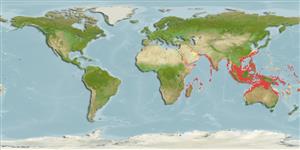Common names from other countries
Environment: milieu / climate zone / depth range / distribution range
Sinh thái học
Biển; Thuộc về nước lợ Cùng sống ở rạn san hô; sống cả ở nước ngọt và nuớc mặn (Ref. 51243); Mức độ sâu 0 - 150 m (Ref. 5222). Tropical; 30°N - 32°S, 29°E - 173°W (Ref. 5222)
Indo-Pacific: Red Sea and East Africa to Tonga, north to Japan, south to Australia. It is not known from the Persian Gulf, where the closely related Epinephelus coioides is common.
Length at first maturity / Bộ gần gũi / Khối lượng (Trọng lượng) / Age
Maturity: Lm 64.0 range ? - ? cm
Max length : 234 cm TL con đực/không giới tính; (Ref. 5213); common length : 100.0 cm TL con đực/không giới tính; (Ref. 5213); Khối lượng cực đại được công bố: 150.0 kg (Ref. 9710)
Các tia vây lưng cứng (tổng cộng) : 11; Các vây lưng mềm (tổng cộng) : 14 - 16; Tia cứng vây hậu môn: 3; Tia mềm vây hậu môn: 8. Characterized by light grey to yellowish brown color; five slightly oblique dark brown bars that bifurcate ventrally; numerous small black spots and blotches in head and body; ctenoid scales on body except cycloid anterodorsally on body, thorax and abdomen; body with auxiliary scales; greatest depth of body 3.0-3.6 in SL; rounded caudal fin; pelvic fins, 2.0-2.6 in head length (Ref. 90102); head length 2.3-2.6 times in SL; snout length 1.7-2.0 times in upper jaw length; interorbital width 4.5-6.5 times in HL and 2.1-3.0 times in upper jaw length; flat or slightly convex interorbital area; subangular preopercle, with enlarged serrae at the angle; almost straight upper edge of operculum; subequal posterior and anterior nostrils, except in large adults which have the posterior nostrils slightly larger; maxilla reaches to or past vertical at rear edge of orbit, maxilla width 4.5-6.5% of SL; upper jaw length 17-22% of SL, 2-5 rows of teeth on midlateral part of lower jaw (Ref. 89707).
A common species found in a variety of habitats: coral and rocky reefs, tide pools, estuaries, mangrove swamps and sandy or mud bottom from shore to depths of 150 m. Solitary (Ref 90102). Juveniles found near shore and in estuaries; sex reversal probable; catch statistics poor being previously confused with E. andersoni (Ref. 4332). Feed primarily on fishes and crustaceans, and occasionally on cephalopods (Ref. 9710). Present in Hong Kong live fish markets (Ref. 27253). Widely used in mariculture mainly in the Far East (Ref. 43448).
Heemstra, P.C. and J.E. Randall, 1993. FAO Species Catalogue. Vol. 16. Groupers of the world (family Serranidae, subfamily Epinephelinae). An annotated and illustrated catalogue of the grouper, rockcod, hind, coral grouper and lyretail species known to date. Rome: FAO. FAO Fish. Synop. 125(16):382 p. (Ref. 5222)
IUCN Red List Status (Ref. 130435)
CITES (Ref. 128078)
Not Evaluated
Threat to humans
Harmless
Human uses
Các nghề cá: tính thương mại cao; Nuôi trồng thủy sản: Tính thương mại; cá để chơi: đúng
Các công cụ
Special reports
Download XML
Các nguồn internet
Estimates based on models
Preferred temperature (Ref.
115969): 24.3 - 29.1, mean 28 (based on 2428 cells).
Phylogenetic diversity index (Ref.
82804): PD
50 = 0.5000 [Uniqueness, from 0.5 = low to 2.0 = high].
Bayesian length-weight: a=0.01230 (0.00808 - 0.01874), b=3.05 (2.93 - 3.17), in cm Total Length, based on LWR estimates for this species & Genus-body shape (Ref.
93245).
Mức dinh dưỡng (Ref.
69278): 4.2 ±0.50 se; based on food items.
Thích nghi nhanh (Ref.
120179): thấp, thời gian nhân đôi của chủng quần tối thiểu là 4.5 - 14 năm (Fec = 51,087).
Fishing Vulnerability (Ref.
59153): Moderate vulnerability (40 of 100).
